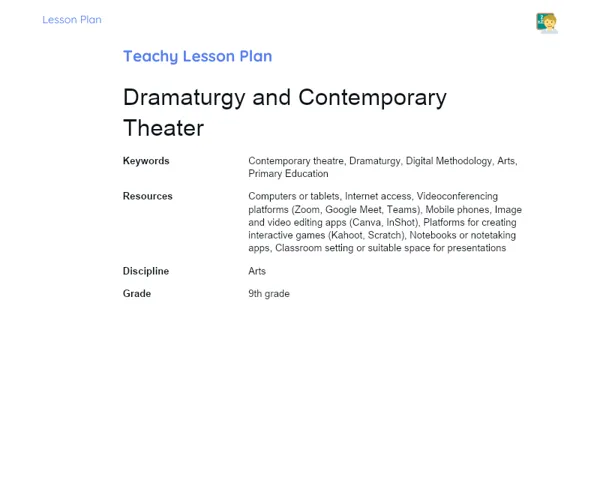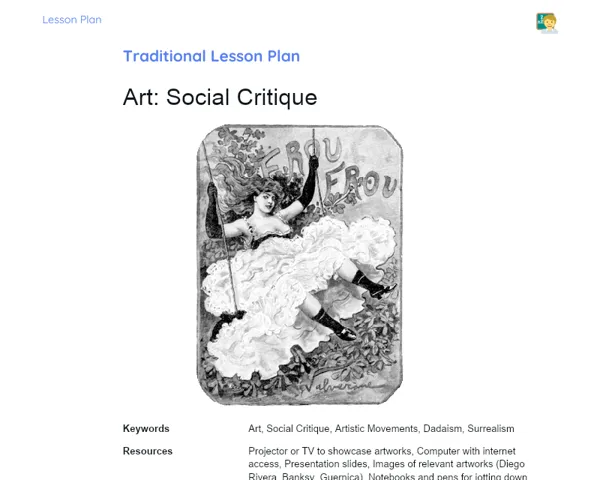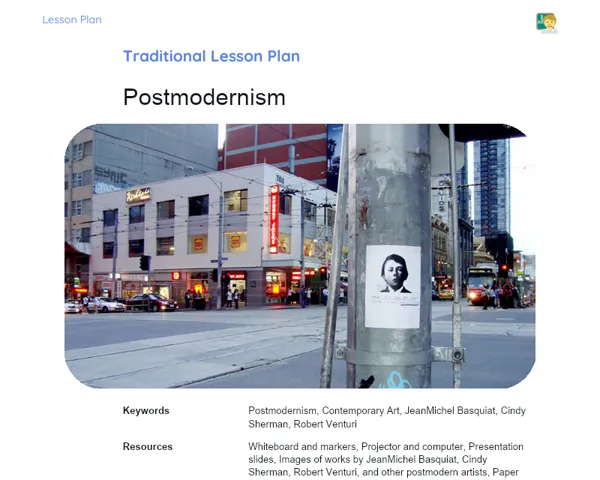Lesson Plan | Lesson Plan Tradisional | Islamic Art
| Keywords | Islamic Art, Islamic Architecture, Islamic Calligraphy, Tapestry, Goldsmithing, Geometric Patterns, Arabesques, Art History, Cultural Influences, Islamic Faith, Great Mosque of Cordoba, Alhambra, Blue Mosque, Calligraphic Styles, Persian Rugs, Inlaying Precious Metals |
| Resources | Multimedia projector, Computer with internet access, Slide presentation (PowerPoint or similar), Images showcasing Islamic art (architecture, calligraphy, tapestry, goldsmithing), Whiteboard and markers, Notebooks and pens for student note-taking, Books and articles about Islamic art, Activity sheets and discussion questions |
Objectives
Duration: (10 - 15 minutes)
The aim of this section is to share the lesson objectives with the students so they have a clear understanding of what will be covered and what skills they will develop. This helps create a firm foundation for learning, enabling students to concentrate on the key aspects of Islamic art and its impact on other artistic disciplines.
Objectives Utama:
1. Identify the unique characteristics of Islamic art and its expression of faith.
2. Understand how Islamic art has influenced various art forms, such as tapestries and goldsmithing.
Introduction
Duration: (10 - 15 minutes)
The purpose of this stage is to capture the students’ interest while laying a solid groundwork for understanding the topic at hand. By providing historical and cultural context and highlighting intriguing facts, students can start to recognize the depth and significance of Islamic art. This serves as an engaging launch pad for the lesson, helping students connect with the content to be explored later.
Did you know?
A fascinating tidbit is that, because of Islamic customs that discourage the depiction of human and animal figures in religious contexts, Islamic artists honed remarkable skills in creating geometric patterns and arabesques. This artistic style not only influenced architecture but also extended to tapestries and goldsmithing, resulting in exceptionally detailed and intricate pieces that continue to be admired today. For instance, many exquisite Persian rugs can trace their origins back to Islamic art and are regarded as true masterpieces.
Contextualization
To kick off the lesson on Islamic art, it’s essential to set the scene for the students about the importance and breadth of this topic. Islamic art has a rich history that spans over a thousand years and reaches across a wide range of geographical areas, including parts of Europe, Africa, and Asia. This art form is more than just religious in nature; it also embodies the culture, science, and accomplishments of Islamic civilizations through time. Islamic artworks are renowned for their intricate designs, symmetry, and use of geometric patterns and calligraphy, often showcased in mosques, palaces, and various historical buildings.
Concepts
Duration: (60 - 65 minutes)
The purpose of this section is to offer a thorough understanding of the fundamental aspects of Islamic art. By exploring specific topics and providing clear examples, students will develop an appreciation for how Islamic art manifests in various forms and its cultural and historical significance. The proposed questions promote contemplation and the application of what they've learned, reinforcing their understanding.
Relevant Topics
1. Introduction to Islamic Art: Discuss the origins and spread of Islamic art, underlining key characteristics like the absence of human and animal depictions in religious settings, the use of geometric patterns, Arabic calligraphy, and arabesques.
2. Islamic Architecture: Elaborate on distinctive architectural features, such as minarets, domes, and mosaics. Provide examples from iconic structures like the Great Mosque of Cordoba, Alhambra, and the Blue Mosque.
3. Islamic Calligraphy: Delve into the significance of calligraphy in Islamic art, emphasizing both its decorative and religious uses. Describe various calligraphic styles, such as Kufic and Naskh.
4. Tapestry and Goldsmithing: Illustrate the influence of Islamic art on tapestry (e.g. Persian rugs) and goldsmithing. Explain the techniques involved and the symbolism behind decorative patterns and motifs.
To Reinforce Learning
1. What are the main features of Islamic architecture, and how do they reflect Islamic culture and faith?
2. Discuss the role of calligraphy in Islamic art and its application in different contexts.
3. In what ways has Islamic art shaped the fields of tapestry and goldsmithing? Provide specific examples.
Feedback
Duration: (10 - 15 minutes)
The goal in this section is to review and solidify the knowledge gained during the lesson, ensuring that students grasp the concepts discussed. Detailed discussions around the questions allow for deeper thought and opportunities to clarify uncertainties. Encouraging student participation through these reflections fosters a more active understanding of the content, prompting connections to broader and personal experiences.
Diskusi Concepts
1. What are the main characteristics of Islamic architecture and how do they embody Islamic culture and faith? 2. Islamic architecture features elements like minarets, domes, and mosaics. These aspects reflect Islamic culture and faith in many ways: for example, minarets are used for the call to prayer, domes symbolize the heavens, and mosaics, often embellished with geometric patterns and arabesques, signify the infinity and perfection of God. The absence of human and animal depictions in religious contexts also aligns with the Islamic view against idolatry. 3. Explain the significance of calligraphy in Islamic art and its varied contexts. 4. Calligraphy holds a prestigious place within Islamic culture, largely due to the significance of the Quran, Islam’s holy text, which is frequently adorned with calligraphy. Styles like Kufic and Naskh are used both in religious texts and decorative arts. Calligraphy can be found in manuscripts, architectural designs, ceramics, and a variety of other artifacts, functioning not just as text but also as an artistic element that celebrates God's word. 5. How has Islamic art impacted tapestry and goldsmithing? Share some examples. 6. Islamic art has played a pivotal role in shaping both tapestry and goldsmithing, particularly seen in the use of geometric patterns and arabesques. Persian rugs, for instance, often exhibit intricate patterns inspired by Islamic imagery. In goldsmithing, techniques like the inlay of precious metals and the use of floral and geometric designs are prevalent. Noteworthy examples include Qum tapestries and stunning jewelry featuring gemstones found across various Islamic regions.
Engaging Students
1. What additional examples of Islamic art can you think of, and how do they compare to what we've discussed in class? 2. In what ways do geometric patterns and Islamic calligraphy influence other art forms you are familiar with? 3. How do you believe the Islamic prohibition on depicting human and animal figures affected the development of Islamic art? 4. Can you spot elements of Islamic art in contemporary pieces or in modern architecture?
Conclusion
Duration: (10 - 15 minutes)
The aim here is to recap and consolidate the insights gained throughout the lesson, ensuring that students comprehend the key points and recognize the practical and cultural significance of what they’ve learned. This final reflection also provides students the chance to relate the content to their own backgrounds and knowledge.
Summary
['Islamic art is marked by the absence of human and animal representations in religious contexts, the application of geometric patterns, Arabic calligraphy, and arabesques.', 'Distinctive architectural features include minarets, domes, and mosaics, illustrated by the Great Mosque of Cordoba, Alhambra, and the Blue Mosque.', 'Islamic calligraphy is highly esteemed and appears in both religious and ornamental contexts, using styles such as Kufic and Naskh.', 'Islamic art has made significant contributions to tapestry and goldsmithing, especially with Persian rugs and inlay techniques for precious metals.']
Connection
The lesson bridged theory and practice by detailing the elements of Islamic art and demonstrating how these aspects appear across various forms of art and architecture. Specific examples of buildings, tapestries, and goldsmithing served to ground these concepts in practical, relatable terms for students.
Theme Relevance
Studying Islamic art is crucial as it helps us appreciate the cultural and aesthetic contributions of Islamic civilizations. Moreover, elements of this art are often present in modern designs and contemporary architecture, showcasing its enduring relevance and influence.



